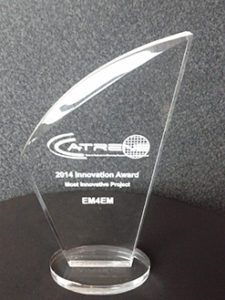Zuken Plays Key Role in Innovation Award Win for Electric Vehicle Research Collaboration
19 December 2014 – Munich, Germany and Westford, MA, USA – Zuken is pleased to announce that the electric vehicle research project in which they are a partner – EM4EM (ElectroMagnetic Reliability and Electronic Systems for Electro Mobility) – has won a European innovation award.

The project was presented with the CATRENE Innovation Award for “Most Innovative Project in 2014” at the European Nanoelectronics Forum 2014, held last month in Cannes, France. CATRENE (Cluster for Application and Technology Research in Europe on NanoElectronics) is an EU-funded research program.
“The results coming out of the CATRENE EM4EM project are pre-conditions for the next generation of electric vehicles and will allow European companies in the automotive industry to secure and expand while preserving or even increasing employment in Europe. Each partner in this interdisciplinary consortium brought requirements and specific expertise that have resulted in effective solutions”, stated Peter Koch, CATRENE Programme Director Applications.
Zuken is the EDA industry representative on the three-year EM4EM project dedicated to tackling electromagnetic compatibility (EMC) problems in electrically-driven cars. Zuken has the lead on the “Advanced EMR Design for Smart System Integration” component, which focuses on modelling and analysis methodology. The project brings together 17 partners from three countries, including Audi, Daimler, Bosch, Infineon, Continental, NXP and ELMOS Semiconductor.
Zuken plays an important role in this research by advancing new technology concepts for EMC-related modelling of power and ground systems for control unit structures and for incorporating power-ground related noise in signal integrity simulation. EMC issues in electric vehicles can become critical due to the high currents and voltages required by electric vehicle engines, while control units operate in the millivolt/milliwatt range but must co-exist without disturbance close to the engine.
Our project was commended by the judges because of its systematic approach. We went from the project level into the specification phase and then from car, system, subsystem, and finally down to package and chip level.
This type of systematic approach is vital to achieve results that can be implemented across the whole electric vehicle sector. We structured the R&D activities according to the V model, which is common in the automotive sector. The project outcome will significantly enhance our analysis capabilities in future.
The project work organization conformed to Automotive SPICE, a quality standard for which Zuken is accredited. The results of this project will be implemented into Zuken’s electronic design and wiring system solutions to create unique benefits for Zuken’s automotive customers.
Zuken has recently expanded its automotive sector activities by establishing a global Automotive and Transportation Competence Center in Germany. In October 2014, Zuken introduced its E3.Harness Analyzer product that offers efficient collaboration for the automotive harness industry as the first tool resulting from this Automotive initiative.
For more information, see www.zuken.com/high-speed-pcb-design or www.catrene.org
– ends –



